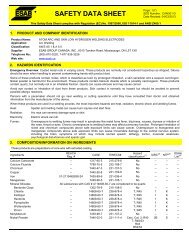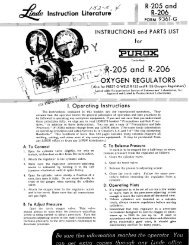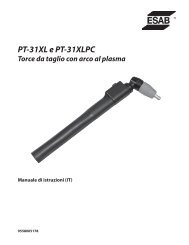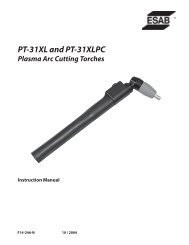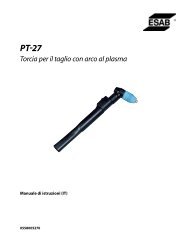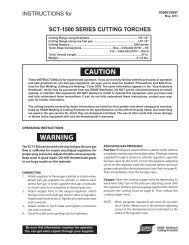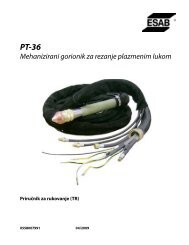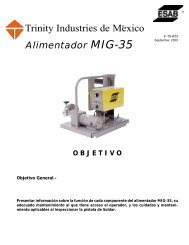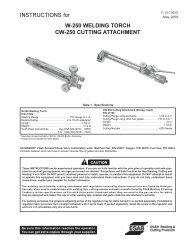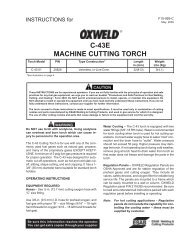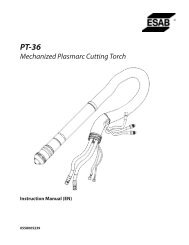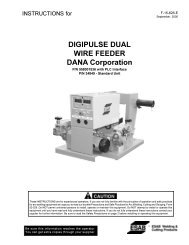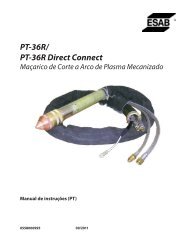Hybrid Laser Welding - ESAB Welding & Cutting Products
Hybrid Laser Welding - ESAB Welding & Cutting Products
Hybrid Laser Welding - ESAB Welding & Cutting Products
You also want an ePaper? Increase the reach of your titles
YUMPU automatically turns print PDFs into web optimized ePapers that Google loves.
Lighting the Way<br />
– <strong>Hybrid</strong> <strong>Laser</strong> <strong>Welding</strong>
H<br />
<strong>Hybrid</strong> <strong>Laser</strong> <strong>Welding</strong> can be used on steel bridge<br />
structures to reduce weight and improve fatigue life.<br />
Mobile equipment benefits from the high production speeds and<br />
lower construction costs of hybrid welding.
ybrid<br />
So – What Is <strong>Hybrid</strong> <strong>Laser</strong> <strong>Welding</strong>?<br />
Quite simply, the best of two worlds.<br />
Combining the key benefits of laser and Gas<br />
Metal Arc <strong>Welding</strong> (GMAW), <strong>Hybrid</strong> <strong>Laser</strong><br />
<strong>Welding</strong> delivers multiple gains, such as<br />
radically higher welding speeds and a dramatic<br />
reduction in consumable consumption. Sound<br />
good? Add enhanced mechanical properties,<br />
reduced joint volumes and heat input and<br />
greatly reduced part distortion. Sound even<br />
better? The introduction of <strong>ESAB</strong>’s fifthgeneration<br />
Hybrio technology launches a<br />
new era in advanced welding.<br />
<strong>Hybrid</strong> <strong>Laser</strong> <strong>Welding</strong> combines a high-energy laser<br />
beam with conventional arc welding (commonly<br />
GMAW) to create an optimal weld pool. The system<br />
can be configured in two ways, for different<br />
applications: with the GMAW torch leading (butt<br />
welds) or the laser leading (fillet welds).<br />
In both of these approaches, the main<br />
function of the laser beam is to penetrate the<br />
weld joint deeply. Combined with the GMAW<br />
process, the laser is able to draw filler metal<br />
into the joint to achieve the desired final weld<br />
geometry and mechanical properties. The hot<br />
spot created by the laser also helps stabilize the<br />
GMAW arc (cathodic stabilization) and the weld<br />
pool, making the hybrid process much faster<br />
than conventional GMAW.<br />
Faster, Cooler, More Productive…<br />
<strong>Laser</strong> and arc interact to stabilize both<br />
processes, resulting in weld speeds far in<br />
excess of conventional arc-only systems. In<br />
combination with the minimal spot size and deep<br />
penetration of the laser, this high travel speed<br />
permits welding of thicker total weld throats,<br />
with radically reduced heat input compared to<br />
conventional fusion welding. Using the hybrid<br />
process, a single weld pass may do, where a<br />
conventional process might need several.<br />
...and Stronger Too!<br />
Ten years of development and exhaustive tests<br />
prove conclusively that hybrid welds are not<br />
only generally as strong, durable and ductile as<br />
conventional welds, but can in some ways be<br />
even better. The low heat input for hybrid welds<br />
creates very fine grain structures, minimizing<br />
base material dilution, achieving high toughness<br />
and making the process especially appropriate<br />
for high performance alloys. Compared to<br />
conventional welds, these very smooth welds<br />
have been shown to improve fatigue limits on<br />
fillet welds by a factor of three.<br />
GMAW (MIG)<br />
Autogenous <strong>Laser</strong><br />
(laser only)<br />
<strong>Hybrid</strong> <strong>Laser</strong><br />
<strong>Welding</strong><br />
Graphic illustrating differences between GMAW, <strong>Laser</strong><br />
and <strong>Hybrid</strong> <strong>Laser</strong> <strong>Welding</strong> weld profiles<br />
To reduce material and construction costs,<br />
companies are shifting to thinner, highstrength<br />
structures, based on high performance<br />
alloys. By reducing hydrogen content and<br />
making cool, fine-grained welds, the Hybrio <br />
process ensures consistently high-quality in<br />
such alloys while simultaneously accelerating<br />
production line throughput.<br />
The process offers many other efficiency<br />
gains. These range from higher welding speeds,<br />
lower operating costs and increased flexibility<br />
to the multiple benefits of a fully automated<br />
welding process. And the PC-based touchscreen<br />
interface makes manual adjustment<br />
history. This enhances operator safety, reduces<br />
risk of human error and cuts training costs.<br />
1<br />
2<br />
3<br />
<strong>Hybrid</strong> <strong>Laser</strong> <strong>Welding</strong> Process<br />
1 Newly formed weld bead<br />
2 Inert shielding gas<br />
3 Focused laser beam<br />
4 GMAW torch<br />
5 Wire electrode<br />
6 Electric arc<br />
7 Molten pool<br />
8 Keyhole<br />
8<br />
6<br />
7<br />
5<br />
4<br />
3
© Copyright: Agility Trains / Hitachi Ltd.<br />
Transportation vehicles of all types, from rail to autos to ships, can use hybrid<br />
welding in combination with high performance materials, to reduce weight<br />
and distortion while enhancing vehicle performance.<br />
ow?<br />
How Can The Hybrio Process Transform My Business?<br />
<strong>Hybrid</strong> welding is not for everyone. It may<br />
mean adjusting cutting/machining operations<br />
and require changes to down-stream<br />
operations, to fully benefit from the substantial<br />
productivity, quality and cost-efficiency gains.<br />
Successful implementation assumes access<br />
to qualified engineering and technical staff.<br />
And introducing such a game-changing new<br />
process demands serious investment, not only<br />
in terms of resources, but in total commitment<br />
from senior management. For those with the<br />
right industrial and product profile, though, the<br />
potential gains are huge.<br />
A fifth-generation self-adaptive hybrid welding<br />
system, <strong>ESAB</strong>’s Hybrio technology leads the<br />
industry in ease of use and process robustness.<br />
By sensing its environment, the joint location<br />
and fit-up, it can adapt the process in real-time<br />
to maintain high weld quality over a wide range<br />
of fit-up conditions. This offers a major advance<br />
in productivity and cost efficiency.<br />
From rolling stock and containers, shipbuilding<br />
and the offshore industry to construction, pipeline<br />
production and the energy sector, this hybrid<br />
process will transform your bottom line. If your<br />
business is high-volume industrial fabrication,<br />
featuring moderate batch sizes and a low part<br />
mix, Hybrio could be the answer.<br />
If you plan to compete with a stronger,<br />
stiffer, lighter product, using high-strength, lowweight<br />
alloys that require a lower heat input –<br />
Hybrio is for you. The operator-friendly PC<br />
interface and flexible, fully-automated weld<br />
process will accelerate throughput, significantly<br />
enhancing productivity. Furthermore, the unique<br />
characteristics of the Hybrio process will slash<br />
consumables costs and downstream post-weld<br />
treatment requirements. Crucially, you gain a<br />
qualitative edge that will generate higher margins.<br />
Gear Up for Higher Speeds, Lower<br />
Costs – and a Broader Client Base<br />
<strong>Hybrid</strong> laser welding is about more than<br />
manufacturing capability. It’s about growing your<br />
business. About enhancing multiple aspects of<br />
production. <strong>Welding</strong> speeds 3-5 times higher<br />
than GMAW (and up to ten times higher than<br />
Submerged Arc <strong>Welding</strong>/SAW). Reduced heat<br />
input of up to 80% (GMAW) and 90% (SAW).<br />
Operational savings of around 50% compared<br />
to GMAW, still greater compared with SAW.<br />
Most importantly, the unique benefits of deep<br />
penetration and low distortion present a whole
new range of exciting product opportunities,<br />
based on the huge potential of the latest highperformance<br />
lightweight alloys and advanced<br />
structure designs.<br />
From Wind Turbines<br />
to Aircraft Carriers<br />
Manufacturers across the entire industrial<br />
spectrum, from the marine and transport<br />
sectors to construction, energy and aerospace,<br />
seek to enhance product performance and<br />
boost cost efficiency by exploiting the latest<br />
high-strength lightweight alloys. The unique<br />
benefits of the hybrid laser process now enable<br />
the development of new joint types, featuring<br />
minimal distortion, increased stiffness and<br />
higher strength. Freed from the constraints of<br />
conventional welding processes, designers can<br />
now create radical high-performance lightweight<br />
structures, based on thin alloy sheet. Laminated,<br />
hollow, cellular or of composite materials, these<br />
new structures are the building blocks of future<br />
industrial success.<br />
5
SAB<br />
Why Choose <strong>ESAB</strong>?<br />
Because <strong>ESAB</strong> is so much more than ‘just’<br />
an equipment supplier. A respected R&D<br />
powerhouse in its own right, <strong>ESAB</strong> works<br />
intimately with end-customers, OEMs and<br />
system integrators to achieve optimal welding<br />
solutions. This goes beyond the practical and<br />
technical challenges, to embrace life-cycle<br />
cost and environmental sustainability. As<br />
an <strong>ESAB</strong> customer, you acquire a powerful<br />
industrial consultant and partner.<br />
And Why Hybrio ?<br />
<strong>ESAB</strong>’s Hybrio technology leads the industry in<br />
ease of use and process reliability. The technology<br />
can be supplied as a fully-integrated turnkey<br />
<strong>ESAB</strong> welding system, or made available to<br />
machine tool OEMs and system integrators as a<br />
process package. Customers always have access<br />
to the company’s comprehensive hybrid welding<br />
expertise, with the full support of <strong>ESAB</strong> <strong>Laser</strong><br />
Process Centers in North America and Europe.<br />
machining or fixturing of parts. A seam-tracking<br />
camera acquires pre-weld positional and volume<br />
data for transmission to the Hybrio processor.<br />
An optional post-weld inspection camera can be<br />
fitted for surface scanning, measurement and<br />
automatic defect detection.<br />
This all translates into multiple technical<br />
and business benefits: greater versatility and<br />
flexibility in large parts and heavy fabrication<br />
applications, accelerated throughput, higher<br />
productivity, reduced material and downstream<br />
costs and improved weld quality.<br />
Exciting Business Opportunities<br />
Whether your focus is beam welding, seam<br />
welding, tube or pipe welding, orbital girth<br />
welding or multi-axis high flexibility welding,<br />
Hybrio technology offers significant gains in<br />
productivity and cost efficiency. As industry<br />
turns increasingly towards advanced structural<br />
designs based on lightweight, high-performance<br />
and corrosion-resistant alloys, <strong>ESAB</strong> must<br />
anticipate its needs through constant innovation.<br />
With the right <strong>ESAB</strong> technology in place, the<br />
market is yours for the taking!<br />
Profit-Generating Innovation<br />
This fifth-generation welding system features<br />
some unique innovations, in particular <strong>ESAB</strong>’s<br />
ground-breaking adaptive process control<br />
system. Able to instantaneously measure joint<br />
position and fit-up quality, it predictively adapts<br />
the process in real-time to maintain optimum<br />
weld quality across a broad range of conditions.<br />
Enhanced weld gap tolerance permits welding of<br />
large structures without the need for excessive
XA00153320 www.npp-reklam.se<br />
ybrio <br />
The Hybrio Value Proposition:<br />
• Operating costs reduced by 50-80%.<br />
• Productivity improved by 300-1000%.<br />
• Heat input and distortion reduced by 80-90%.<br />
• Reduced weld repair rates.<br />
• Reduced labor content through fully automated operation.<br />
• Reduced operator skill requirement due to easy,<br />
PC-based machine controller.<br />
• Lower downstream assembly, welding and finishing costs,<br />
through reduced part distortion.<br />
• Higher overall plant throughput and revenue generation.<br />
• Feasibility of new, lighter, stiffer and simpler product design<br />
and construction methods.<br />
• Full backing and support of <strong>ESAB</strong>’s process experts<br />
and service professionals, with extended warranty and<br />
service agreements.<br />
<strong>ESAB</strong> <strong>Welding</strong> & <strong>Cutting</strong> <strong>Products</strong> / esabna.com / 1.800.<strong>ESAB</strong>.123<br />
USA: P.O. Box 100545, 411 South Ebenezer Road, Florence, SC 29501-0545<br />
Canada: 6010 Tomken Road, Mississauga, Ontario L5T-1X9<br />
Mexico: Ave. Diego Díaz de Berlanga No. 130, Col. Nogalar San Nicolás<br />
de Los Garza N.L. CP 66480 Monterrey, Mexico<br />
AUT-1003 3/11<br />
Find us facebook.com/esabna twitter.com/esabna youtube.com/esabweb



